
Steriflow Pressure Reducing Valves (DROOP)
Induchem Group are a supplier of Steriflow pressure reducing valves. Contact sales@induchemgroup.com for more information on our range.
What is PRV Offset (droop) and Why Does it Occur?
All pressure reducing valves show a drop in set point pressure (Offset, Droop) as the flow through the valve increases. Offset is described as a % charge in set point pressure as flow changes. The graph below (Example 1.) explains the changes for two different types of regulators. Offset is caused by many physical forces that act on the diaphragm, spring and plug as flow changes. All of the forces acting upon the regulator are illustrated in Example 2.
Example 1.


Example 2.

The amount of set point offset (the degree of the slope) is dependent on a variety of different factors. Some factors are essential to all regulator designs and cannot be controlled by the user. Other factors can be controlled by the user, either by regulator selection or installation and operation practices.
Factors that influence offset that are essential to regulator design:
Some amount of droop is intrinsic to all regulator designs.
There are several physical forces acting on the Diaphragm, Spring and Plug as flow changes that cause offset. These forces can never be completely eliminated from any manufacturers design.
They can be influenced by a regulator manufacturer’s basic design, and are therefore under the control of the person that selects a particular regulator design and it’s specific features or options. Regulators with large diaphragm areas, a small amount of total stroke (distance the stem moves from full open to full close), and a properly selected spring relative to the set point, generally have less offset than those that don’t have those features.
Diaphragm area: the lines in the test chart (Example 1 above) shows the difference in offset of two different regulators on the same application. The red line is the offset curve for a small, clean gas and air regulator’s diaphragm with about the same total stroke length and spring rate as the large diaphragm regulator that produced the blue offset curve. In this instance, the difference in offset performance primarily has to do with the diaphragm area difference.
Stroke Length: A regulator with a shorter total stroke will outperform a regulator with a longer stroke if all other factors are held constant.
Spring rate or compression at set point: Selecting the right spring range for your specific regulator set point can influence offset.
In general, the more compressed the spring is at your set point pressure, the less offset exhibited. Therefore, when selecting a spring range for your regulator, select a spring range that puts your set point closer to the upper end of the spring range. The droop figures circled in the comparative graphs below give an example of this. A spring range of 5 to 25 psi is clearly a better spring choice for a 15 psi set point than the 15 to 50 psi range spring.


Forces Acting on the Plug: Regulators with larger diaphragms are much less susceptible to the hydraulic and velocity forces acting on the plug.
The force acting on the small plug of a large diaphragm regulator is insignificant relative to the force acting on that regulators diaphragm because of the relative area those forces are acting on. (Force = Pressure x Area). By contrast, small clean air and gas style regulators have a much smaller diaphragm area in relation to the plug. They are therefore more susceptible to forces acting on the plug. As a result they exhibit more offset.
